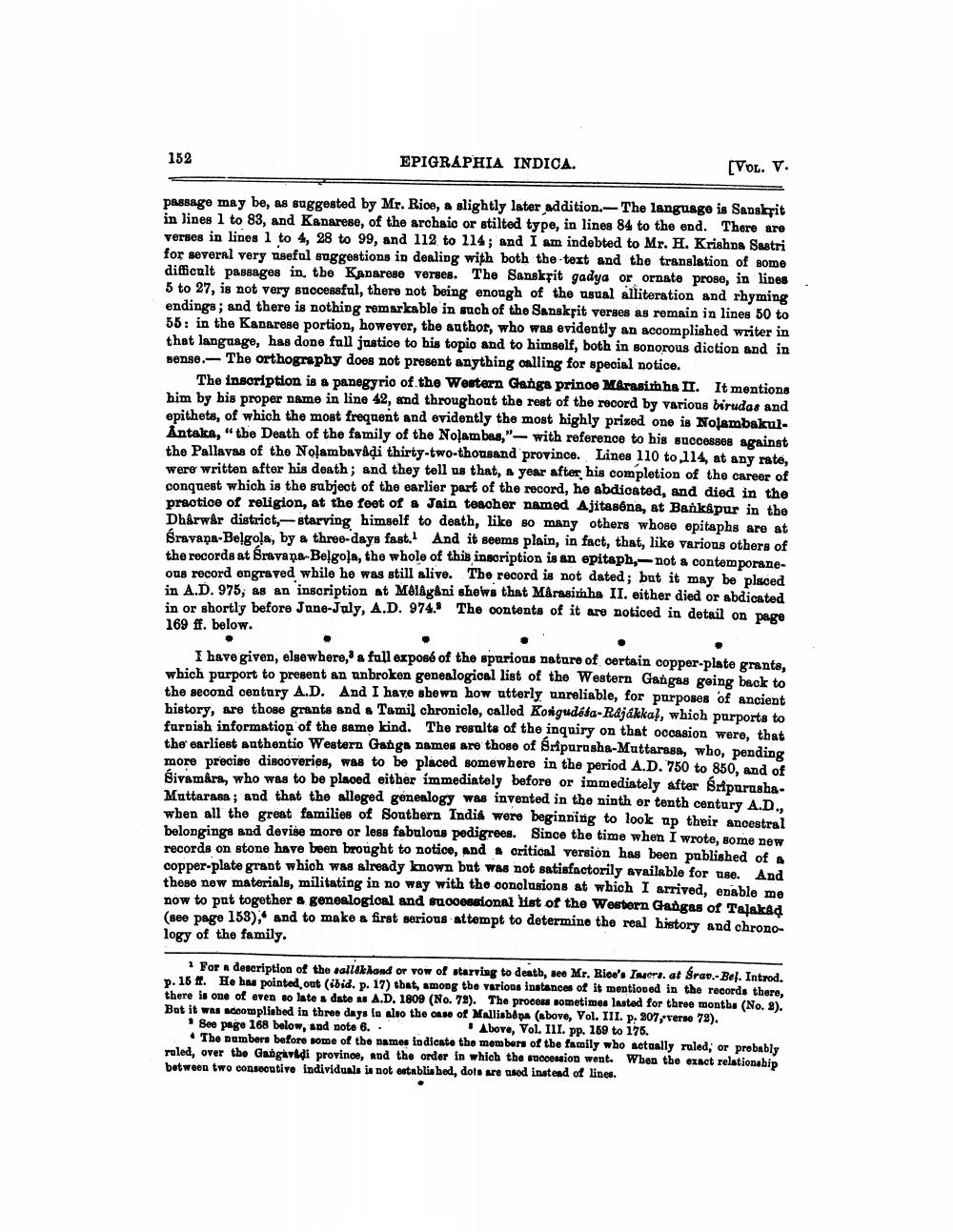________________
152
EPIGRAPHIA INDICA.
[Vol. V.
passage may be, as suggested by Mr. Rice, a slightly later addition. The language is Sanskrit in lines 1 to 83, and Kanarese, of the archaic or stilted type, in linea 84 to the end. There are verses in lines 1 to 4,28 to 99, and 112 to 114; and I am indebted to Mr. H. Krishna Sastri for several very useful suggestions in dealing with both the text and the translation of some difficult passages in the Kadarese verses. The Sanskrit gadya or ornate prose, in lines 5 to 27, is not very successful, there not being enough of the usual alliteration and rhyming endings, and there is nothing remarkable in such of the Sanskrit verses as remain in lines 50 to 55: in the Kadarese portion, however, the author, who was evidently an accomplished writer in that language, has done full justice to his topic and to himself, both in sonorous diction and in sense. The orthography does not present anything calling for special notice.
The insoription is a panegyrio of the Western Ganga prinos Marasimha II. It mentions him by his proper name in line 42, and throughout the rest of the record by various birudas and epithets, of which the most frequent and evidently the most highly prized one is Nolambakul. Antaka, "the Death of the family of the Nolambas," - with reference to his successes against the Pallavas of the Noļambavadi thirty-two-thousand province. Lines 110 to 114, at any rate, were written after his death; and they tell us that, a year after his completion of the career of conquest which is the subjeot of the earlier part of the record, he abdicated, and died in the practice of religion, at the feet of a Jain teacher named Ajitas@na, at Bankapur in the Dharwar district,-starving himself to death, like so many others whose epitaphs are at Śravana-Belgola, by a three-days fast. And it seems plain, in fact, that, like various others of the records at Sravana-Belgola, the whole of this inscription is an epitaph, not a contemporaneons record engraved while he was still alive. The record is not dated; but it may be placed in A.D. 975, as an inscription at Mølågâni shews that Marasimha II. either died or abdicated in or shortly before Jane-July, A.D. 974. The contents of it are noticed in detail on page 169 ff. below.
I have given, elsewhere,' a fall exposé of the spurious nature of certain copper-plate grants, which purport to present an unbroken genealogical list of the Western Gangas going back to the second contury A.D. And I have shewn how utterly unreliable, for purposes of Ancient history, are those grants and a Tamil chronicle, called Kongudóta-Rajákkal, which purports to furnish information of the same kind. The results of the inquiry on that occasion were, that the earliest authentio Western Ganga Dames are those of Sripurasha-Muttarasa, who, pending more precise discoveries, was to be placed somewhere in the period A.D. 750 to 850, and of Sivamára, who was to be plaoed either immediately before or immediately after SupurushaMattarasa; and that the alleged genealogy was invented in the ninth or tenth century A.D., when all the great families of Southern India were beginning to look up their ancestral belongings and devise more or less fabulous pedigrees. Since the time when I wrote, some new records on stone have been brought to notice, and a critical version has been published of a copper-plate grant which was already known but was not satisfactorily available for use. And these now materials, militating in no way with the conclusions at which I arrived, enable me now to put together a genealogical and successional list of the Western Gangas of Talakad (see page 158)and to make a first serious attempt to determine the real history and chronology of the family.
1 Por description of the sallkhand or vow of starving to death, seo Mr. Biod's Insers. at Srar.- Bel. Introd. p. 16. He has pointed out (ibid. p. 17) bat, among the various instances of it mentioned in the records there, there is one of even so late a date as A.D. 1809 (No. 72). The process sometimes lasted for three months (No. 9). Bat it was accomplished in three days to also the case of Mallisbps (above, Vol. III. p. 207,verse 72). See page 168 below, and note 6.
Above, Vol. III. pp. 169 to 175. The numbers before some of the names indicate the members of the family who actually ruled, or probably ruled, over the Gangavadi province, and the order in which the succession went. When the exact relationship between two consecutive individuals is not established, dots are used instead of lines.




